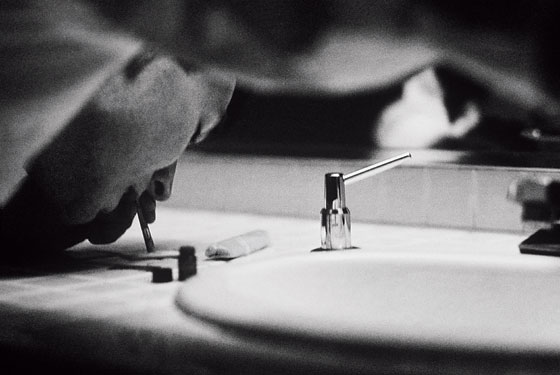 |
(Photo: Bruce Ayres/Getty Images) |
I first remember hearing the Y-word in ’83, when I was living in the East Village, sharing an apartment with my best friend while working on my first novel and paying the bills as a slush-pile reader at Random House. I was enjoying a hung-over midday breakfast (we didn’t use the word brunch in the East Village; it was breakfast whenever you woke up) at Veselka on Second Avenue. My former breakfast spot, the Binibon, had recently been shuttered, having never recovered after Jack Henry Abbott stabbed waiter-playwright Richard Adan outside, on the sidewalk. An ostentatiously besplattered painter I used to see around the neighborhood was sitting next to me at the counter, and I heard him mutter, “Fucking yuppies.” I looked up to see a young couple I myself would have characterized as “preppy” waiting to be seated. They looked as if they were visiting from the Upper East Side—all chinos and oxford cloth. We were all uniformly nonconformist in our black jeans and our black Ramones and Television T-shirts. As a Williams alum, I knew all about preppies even before they’d gone mainstream with the publication of The Official Preppy Handbook in 1980. My younger brother, a Deerfield senior, was a preppy. Many of my classmates were preppies. But this yuppie thing was new to me.
The term probably first appeared in print in 1983, when columnist Bob Greene wrote a piece about former Yippie leader Jerry Rubin, who was hosting “networking” events at Studio 54. Greene quoted a participant as saying that Rubin had gone from being the leader of the Yippies to the leader of the yuppies. The neologism stood for Young Urban Professionals and might have gone down in history as yups if not for the Rubin connection. The term yuppies suggested a certain evolutionary—or devolutionary—trajectory from the hippie and the Yippie. The story had everything—the double irony of the revolutionary trickster turned entrepreneurial capitalist cheerleader and the setting in the glam palace of mindless hedonism, as well as a zippy catchphrase that actually seemed to describe an instantly recognizable new minority. Once we had a name for them, we suddenly realized that they were everywhere, like the pod people of Invasion of the Body Snatchers—especially here in New York, the urbanest place of all. We might have even recognized them as us.
Not long after my first actual sighting, I would see the earliest DIE YUPPIE SCUM graffiti around the neighborhood, an epithet that was soon vying in popularity with that LES perennial EAT THE RICH. The vituperative tone with which the Y-word was pronounced on East Fifth Street was in part a function of rapidly escalating real-estate prices in the East Village; after decades of relative stability that had made the area a bastion of Eastern European immigrants and young bohemians, though, it’s easy to forget at this distance that it was also a war zone where muggings and rapes weren’t considered news. The Hells Angels ruled East Third Street, and after dark you went east of Second Avenue strictly at your own risk. The cops didn’t go there. East Tenth beyond Avenue A was a narcotics supermarket where preteen runners scampered in and out of bombed-out tenements. In fact, great swatches of the city were dirty and crime-ridden. Even the West Village was pretty gritty by today’s standards, and Times Square was a scene of spectacular squalor. Check out Taxi Driver or The French Connection if you want to get a sense of what this urban wasteland looked like.
It wasn’t just the way the city looked, though. New York was, on the whole, a much more parochial place back then, much more divided along ethnic and class lines. Little Italy was still mostly Italian, the East Village heavily Ukrainian. Wealthy Wasps still clustered on the Upper East Side, west of Third Avenue, and Harlem, of course, was 99 percent black, and many white people lived in mortal terror of nodding off on the subway and waking up at 145th Street. The white middle class was draining away from the city, heroin was epidemic, and crime rampant. When I first moved here, getting mugged was a rite of passage. Both of my first two apartments were broken into, and the 1966 Volkswagen my parents bought me for graduation was stolen not once but twice. This was pre-yuppie Manhattan, a city, dare I say it, in desperate need of gentrification.
In the latter half of the seventies, it was a semi-serious idea that the city would be abandoned by the affluent, the young, and the fleet, left to the poor and the halt and the aged. But sometime after the election of Ronald Reagan, in 1980, it became clear that New York had pulled up its socks and reversed the fiscal, physical, and psychic dilapidation of the seventies. The stock market began a steady ascent, which created new jobs on Wall Street. At some point, the influx of ambitious young strivers started to exceed the exodus, and while many of them gravitated toward the traditionally bourgeois neighborhoods of the Upper East Side, others began to reclaim the housing stock of previously marginal or downright dangerous areas like upper Amsterdam and Columbus, or to colonize old factory buildings in nonresidential neighborhoods like Soho and Tribeca and the East Village. When artists did this, it was called homesteading. When people whose day jobs required them to wear leather shoes (yuppies) followed the artists, it was called gentrification.

